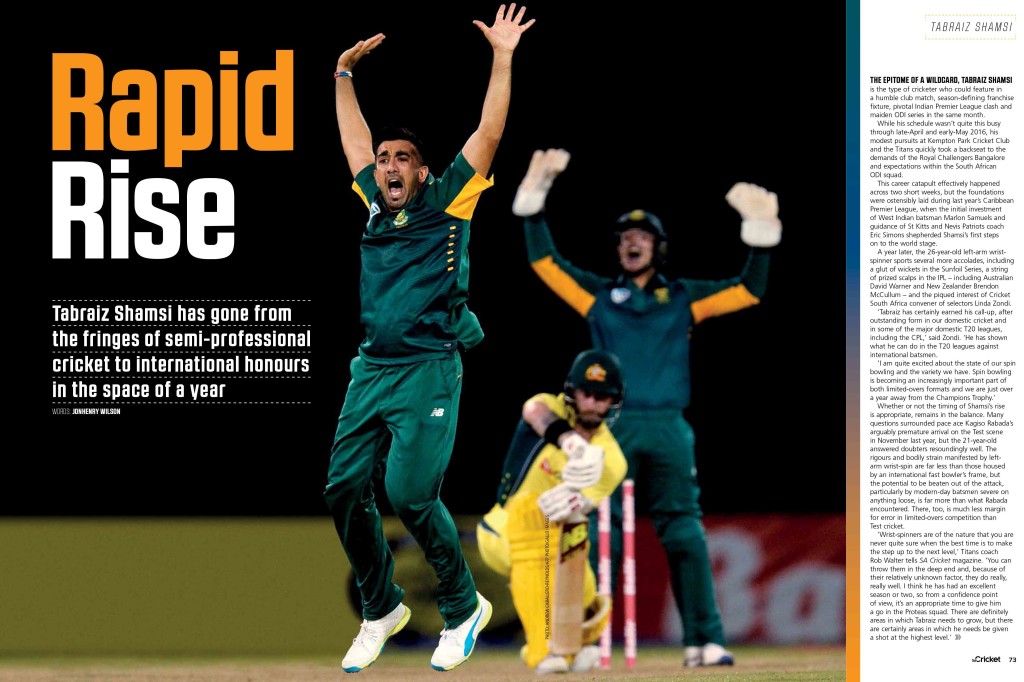We take a look at Tabraiz Shamsi’s rapid rise, featured in the latest edition of SA Cricket magazine.
The epitome of a wildcard, Tabraiz Shamsi is the type of cricketer who could feature in a humble club match, season-defining franchise fixture, pivotal Indian Premier League clash and maiden ODI series in the same month.
While his schedule wasn’t quite this busy through late April and early May 2016, his modest pursuits at Kempton Park Cricket Club and the Titans quickly took a backseat to the demands of the Royal Challengers Bangalore and expectations within the South African ODI squad.
This career catapult effectively happened across two short weeks, but the foundations were ostensibly laid during last year’s Caribbean Premier League, when the initial investment of West Indian batsman Marlon Samuels and guidance of St Kitts and Nevis Patriots coach Eric Simons shepherded Shamsi’s first steps on the world stage.
A year later, the 26-year-old left-arm wrist-spinner sports several more accolades, including a glut of wickets in the Sunfoil Series, a string of prized scalps in the IPL – including Australian David Warner and New Zealander Brendon McCullum – and the piqued interest of Cricket South Africa convener of selectors Linda Zondi.
‘Tabraiz has certainly earned his call-up, following outstanding form both in our domestic cricket and in some of the major domestic T20 leagues, including the CPL. He has shown what he can do in the T20 leagues against international batsmen. I am quite excited about the state of our spin bowling and the variety we have. Spin bowling is becoming an increasingly important part of both limited-overs formats and we are just over a year away from the Champions Trophy in England,’ said Zondi.
Whether or not the timing of Shamsi’s rise is appropriate remains in the balance. Plenty of questions surrounded pace ace Kagiso Rabada’s arguably premature arrival on the Test scene in November last year, but the 21-year-old answered doubters resoundingly well. The rigours and bodily strain manifested by left-arm wrist-spin are far less than those housed by an international fast bowler’s frame, but the potential to be beaten out the attack, particularly by modern-day batsmen severe on anything loose, is far more than what Rabada encountered. There, too, is much less margin for error in limited-overs competition than Test cricket.
‘Wrist-spinners are of the nature that you are never quite sure when the best time is to make the step up to the next level. You can throw them in the deep end and, because of their relatively unknown factor, they do really, really well. I think he has had a really good season or two, so from a confidence point of view, it’s a nice time to give him a go in the Proteas squad. There are definitely areas in which Tabraiz needs to grow, but there are certainly areas in which he needs be given a shot at the highest level,’ (then) Titans coach Rob Walter tells SA Cricket magazine.
‘He needs to believe there are greater things to come,’ adds Walter. ‘Fortunately, he has had some acknowledgement along the way, including his selection for the Proteas’s ODI Tri-Nation series with Australia and West Indies. I hope that will spur him on to challenge more, to train better and harder and achieve more. The exciting thing for me, above all of this, is that there is still a long way to go for his bowling. If he is already achieving these sorts of things – Proteas call-ups and the like – it’s really exciting to see exactly how far he might get to.’
Incidentally, Shamsi originally wanted to be a fast bowler. A tough decision as a teenager, though, changed his trajectory completely, and is testimony to the foresight, perseverance, ebbs and flow of a career that probably wouldn’t have reached the heights it has, had he not fundamentally differentiated himself from the pack at an early age.
‘I was a keen fast bowler at school, but my dreams were shattered when I got to grade eight and it was evident I wasn’t quick enough to be a fast bowler. So, there was a time that I chose between becoming a left-arm orthodox bowler or a left-arm wrist-spinner. The guys that coached me knew that left-arm orthodox would be easier for me to control, but I’m really grateful for the decision I made as a 14-year-old to instead become a left-arm wrist spinner. Not taking the easier option, really, has seen me make something of a career with my bowling,’ Shamsi tells SA Cricket magazine.
‘From here on in, all I can do is get in there and just try to do better than anyone else might have. The rest will take care of itself. I am a firm believer in hard work. Put in the hard work and you will be okay. Those are the sorts of things that have served me well enough so far and I will continue to look to them.’
From the Lions to the Dolphins to Easterns, Shamsi has been a veritable journeyman since November 2009’s first-class and List A debuts. While continuity in performance and selection evaded him in the past and hampered his maiden stint in the IPL, he has found a fitting home at the Titans.
The Pretoria-based outfit has afforded him scope largely unavailable at other franchises. The opportunity and freedom to work on a burgeoning flipper, effective slider, perplexing googly and alternative deliveries have stitched Shamsi that much closer to becoming the complete product.
‘He was not getting much game time in KwaZulu-Natal. Coach Grant Morgan contacted me and said he believed Shamsi was ready to play franchise cricket if the Titans had space for him. Grant is a guy who I have known for a very long time and I trust his cricket intuition. We signed Tabraiz on that basis and have worked really, really hard on his game over the past couple of seasons,’ says Walter.
‘I wouldn’t say it’s coincidental that his first Proteas call-up coincided with his time at the Titans, not to say that he wouldn’t have achieved this elsewhere. I think our environment at the Titans has allowed him the opportunity to push for higher honours. It’s certainly allowed him the type of discipline and push he needed to really grow his game to the necessary levels.
‘He invests a lot of energy into his bowling. Like anyone else, he needs to be pushed to find that extra little bit of something. There is no shortage of skills from Tabraiz, it’s just about getting his mindset right and pushing him to want more from himself.
‘He is not short of time in the nets and working on his game. I think there is still going to be sometime before we see the flipper genuinely come out. I know spending some time with Imran Tahir at the Proteas will be good for him. Getting that kind of specialist information about how to bowl it and what the different options are will help him a lot. Experientially, the time he spends with Tahir will be as good as gold.’
Deployed as a first-change and death bowler in club cricket, frequently used post-powerplay in the CPL and IPL and no foreigner to lengthy spells at first-class level, how exactly ODI captain AB de Villiers and T20I skipper Faf du Plessis extract maximum effect from Shamsi is vital for the bowler and the team.
Easterns teammate and Kempton Park Cricket Club premier league captain Johan Fourie has seen Shamsi utilised at various crucial junctures and, while international cricket is a substantially greater challenge, ‘fields set for a chinaman bowler need to be appropriate and complementary no matter what level one is playing at.’
Titans captain Henry Davids grasped this concept relatively quickly during 2015-16’s title-winning campaign, while Royal Challengers captain Virat Kohli wasn’t really afforded the time nor relationship with the bowler to do so and ultimately faltered. De Villiers and eventually Du Plessis, hopefully, will promptly strike the right balance.
Written by Jonhenry Wilson – a freelance cricket writer for ESPNCricinfo, among others.







